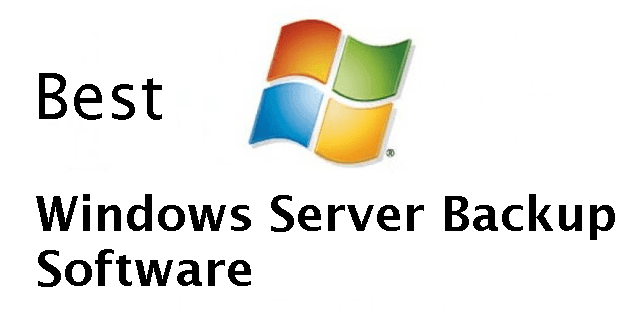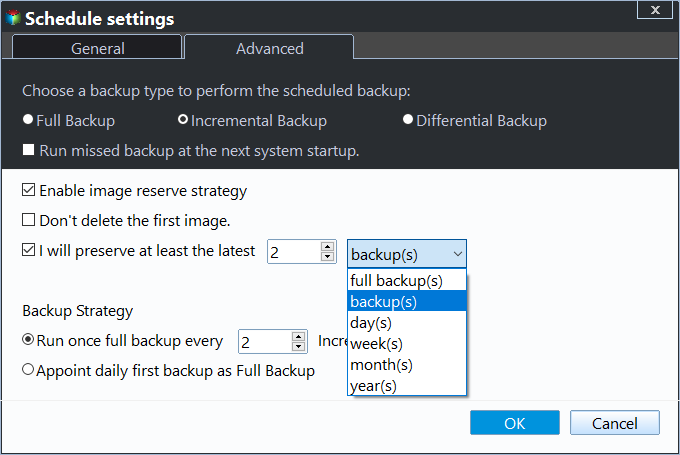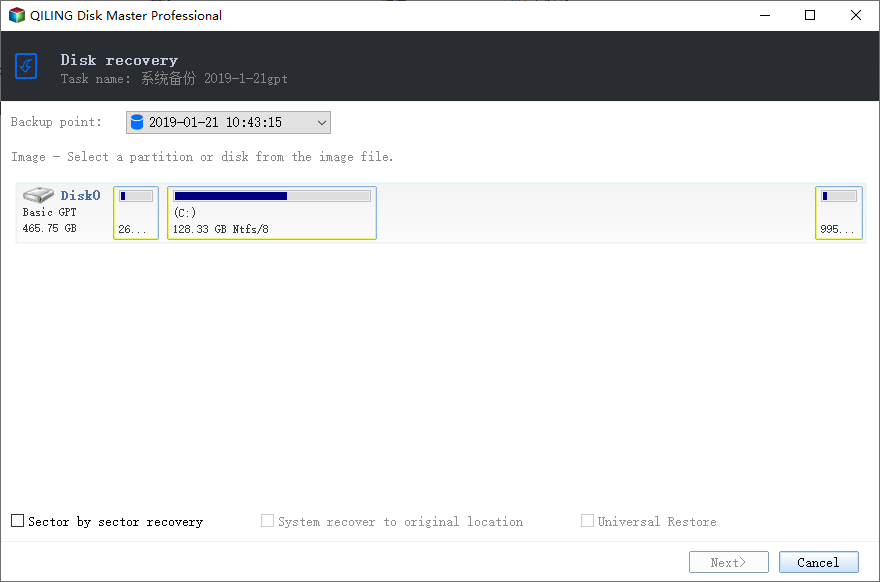Top 5 Reliable Windows Server Backup Software | 2024
- Why Windows Server backup software important?
- 2 built-in backup tools in Windows Server
- Best 3 Windows Server backup software (free & paid)
- 1. Qiling Disk Master Server (paid yet affordable)
- 2. Qiling Backup (limited free)
- 3. Cobian Reflector (free)
- How to create a backup in Windows Server (step-by-step guide)
- Summary
Why Windows Server backup software important?
Suffering from data loss, As more people recognize the significance of data backup, particularly for server users, the importance of having a reliable backup system becomes increasingly evident. Many businesses store vital customer information, company profiles, and ongoing projects on server computers, making it crucial to avoid the costly consequences of data loss in the event of a disaster, such as system crashes, virus infections, hacker attacks, hard disk failures, or human errors.

Having regular backups with the best Windows Server backup software can be a lifesaver in case of data loss. By restoring backup images created beforehand, an administrator can quickly recover and get back to normal, saving time, effort, and resources.
In addition, a well-A configured system backup image can be used to deploy a large scale of computers from a network, or perform bare metal recovery, eliminating the need to install Windows on each machine individually.
- 2 built-in backup tools in Windows Server
- Best 3 Windows Server backup software (free & paid)
- How to create a backup in Windows Server
2 built-in backup tools in Windows Server
The Windows built-Many users prefer backup software, which is often free, and on server systems, Windows Server Backup (WSB) and its command-line version, Wbadmin, are popular choices.
The previous method is generally the first choice due to its intuitive interface and easy-to-use backup guide. However, if you want to customize a backup task, the wbadmin command will be a better option, offering more flexibility and control.
| Windows Server Backup and Wbadmin | |
| Backup Solutions | Backup the operating system, disk, partition or individual files. |
| Backup Types | Full backup or incremental backup. |
| Backup Versions | WSB only supports one schedule backup, whereas Wbadmin allows for multiple schedules with customizable parameters. |
| Backup Storage Devices | Local disks, external hard drives, USB flash drives, and NAS devices are all viable options for storing backups. However, note that scheduled backups to a network share will only be completed with full backups. |
| Backup Schedule | WSBC only supports "Once a day" or "more than once a day" while the wbadmin is more flexible. |
Yes, there are several backup software options that integrate a user-friendly interface with flexible schedule settings, such as Veeam Backup & Replication, Acronis Backup, and Datto. These tools offer a simple and intuitive interface for common users, while also providing advanced features and flexible schedule settings for more complex backup and recovery tasks.
Best 3 Windows Server backup software (free & paid)
For those who need to back up their servers, there are two easy-to-use programs available. These programs can help ensure that your server data is safely stored and can be easily restored in case of a problem. By using one of these programs, you can have peace of mind knowing that your server data is protected.
1. Qiling Disk Master Server (paid yet affordable)
Qiling Disk Master Server offers six backup types, including System Backup, Disk Backup, Partition Backup, File Backup, Cloud Backup, and Outlook Backup, with support for various storage destinations.
This software allows for automatic backups with customizable schedule settings, including daily, weekly, monthly, and event-driven triggers, as well as backing up via USB. It supports both Windows Server and PC systems, including various versions of Windows.
|
Pros |
Cons |
|
+ Backup all kinds of data on your PC + A wide range of backup locations + Support full/incremental/differential backup + Versatile schedule settings + Compress, split, encrypt backup images + Create bootable rescue media |
- Only 30-The website offers a 1 day free trial. After that, you need to pay $149.00 per year. |
Download Qiling Disk Master here:
For unlimited PCs and servers, consider Qiling Disk Master Technician Plus edition, which allows deploying system images to multiple computers simultaneously, even on dissimilar hardware. Additionally, you can create a portable version on a removable device, enabling use on any computer without reinstallation.
2. Qiling Backup (limited free)
Qiling Backup is the best enterprise backup software, offering a convenient and reliable solution for centralized backup management of all Windows operating systems. It allows creating backup tasks for multiple Windows PCs and Servers, and managing them from a single central console.
|
Pros |
Cons |
|
+ Centralized management + System/disk/partition backup + Full/incremental/differential backup + Daily/weekly/monthly backup |
The free edition allows backing up a maximum of 3 PCs and 1 Server. - Does not support file backup. |
Download Qiling Backup here:
3. Cobian Reflector (free)
Cobian Reflector is a free file-backup program for Windows PC and Server systems that can be run as a service or application. It allows for automatic backups of directories and files, with options to save to the same computer, network, or an FTP server. Additionally, backup compression and encryption are supported.
|
Pros |
Cons |
|
+ Support a dummy backup for test + Backup to local/network location or FTP server + Versatile schedule settings + Industry-standard encryptions such as AES 128, 192, and 256 |
- Only support file/folder backup |
Download Cobian Reflector here.
How to create a backup in Windows Server (step-by-step guide)
To create a system backup and file backup in Windows Server, you can follow these steps. First, create a system backup by going to the "Control Panel," then "System and Security," and finally "Backup and Restore.
Backup Server OS with Qiling Disk Master
Launch Qiling Disk Master, click Backup, select System Backup, choose destination path, and click Proceed to create a system image on the server computer.
To create an automatic backup, click on "Schedule Backup" at the bottom and select a backup frequency - Daily, Weekly, Monthly, or Event triggers, or choose to back up when a USB is plugged in.
For a long-To resolve the issue of a full backup disk due to accumulated backup images and limited space, consider setting a high compression level, customized splitting, or implementing automatic backup cleanup. Among these options, automatic backup cleanup is the most thorough way to resolve the issue, as it will automatically delete old backups to release disk space.
💡 Tip on how to restore system:
With a backup image, you can restore your system to a new hard drive, and if your computer is unbootable, you'll need to create bootable media using Qiling Disk Master.
To recover your system, start your computer from the bootable drive, switch to the Restore tab, select the backup image and destination drive, and then click Proceed to execute the recovery process.
If you want to restore a system to a new computer with different hardware, check if the Universal Restore feature is enabled. This feature helps install necessary drivers for system startup.
Summary
For Windows Server backup, using the built-in software can be restrictive and error-prone, making third-party options a better choice. If you only need to backup specific files or folders, Cobian Reflector is a good option. For backing up multiple devices, Qiling Backup is a suitable choice. If you need a comprehensive backup solution for your Windows Server, Qiling Disk Master Server is a good all-around option.
Qiling Disk Master Server allows you to backup system, disk, partition, and files, and customize a scheduled task with different frequencies or upon a specific event or USB drive. It also helps minimize disk space usage by default and provides advanced features like differential backup and automatic backup cleanup.
Acronis True Image can be used as server cloning software, allowing you to clone an OS or entire disk in Windows Server.
Related Articles
- Best Windows Server Cloud Backup Software
- 2 Best Server Backup Solutions to Backup Server Safely 2020
Try the following 2 server backup solutions to less downtime and recovery faster. Perform disaster recovery if something bad happened to your Windows Server. - How to Do Windows Server 2012/2016 Offsite Backup Easily?
Windows Server offsite backup saves a lot of troubles that may happen with onsite backup. This article tells how to perform offsite backup on Windows Server 2012/2016 with reliable software. - Guide on How to Create a System Image Backup of Windows 11 on USB Drive
A system image backup is a full backup of your computer system's state. Using backup tools you will be able to create and use these backups to prevent data loss disasters from affecting your operating system. In this article, we will show you how to backup Windows 11 to a USB drive and restoring from system image backups.



